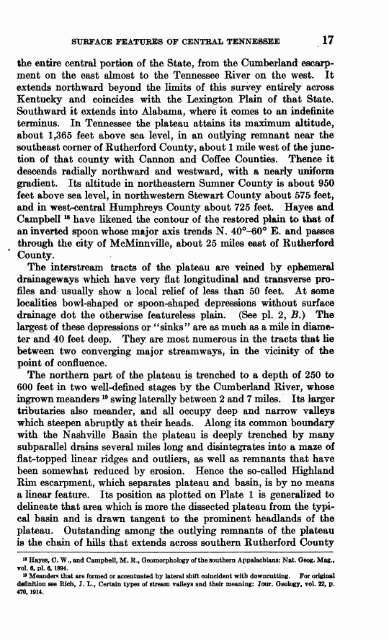GROUND WATER IN NORTH-CENTRAL TENNESSEE
GROUND WATER IN NORTH-CENTRAL TENNESSEE
GROUND WATER IN NORTH-CENTRAL TENNESSEE
You also want an ePaper? Increase the reach of your titles
YUMPU automatically turns print PDFs into web optimized ePapers that Google loves.
StJBFACE FEATURES OF <strong>CENTRAL</strong> <strong>TENNESSEE</strong> 17<br />
the entire central portion of the State, from the Cumberland escarp<br />
ment on the east almost to the Tennessee River on the west. It<br />
extends northward beyond the limits of this survey entirely across<br />
Kentucky and coincides with the Lexington Plain of that State.<br />
Southward it extends into Alabama, where it comes to an indefinite<br />
terminus. In Tennessee the plateau attains its maximum altitude,<br />
about 1,365 feet above sea level, in an outlying remnant near the<br />
southeast corner of Rutherford County, about 1 mile west of the junc<br />
tion of that county with Cannon and Coffee Counties. Thence it<br />
descends radially northward and westward, with a nearly uniform<br />
gradient. Its altitude in northeastern Sumner County is about 950<br />
feet above sea level, in northwestern Stewart County about 575 feet,<br />
and in west-central Humphreys County about 725 feet. Hayes and<br />
Campbell w have likened the contour of the restored plain to that of<br />
an inverted spoon whose major axis trends N. 40°-60° E. and passes<br />
through the city of McMinnville, about 25 miles east of Rutherford<br />
County.<br />
The interstream tracts of the plateau are veined by ephemeral<br />
drainageways which have very flat longitudinal and transverse pro<br />
files and usually show a local relief of less than 50 feet. At some<br />
localities bowl-shaped or spoon-shaped depressions without surface<br />
drainage dot the otherwise featureless plain. (See pi. 2, B.} The<br />
largest of these depressions or "sinks" are as much as a mile in diame<br />
ter and 40 feet deep. They are most numerous in the tracts that lie<br />
between two converging major streamways, in the vicinity of the<br />
point of confluence.<br />
The northern part of the plateau is trenched to a depth of 250 to<br />
600 feet in two well-defined stages by the Cumberland River, whose<br />
ingrown meanders 19 swing laterally between 2 and 7 miles. Its larger<br />
tributaries also meander, and all occupy deep and narrow valleys<br />
which steepen abruptly at their heads. Along its common boundary<br />
with the Nashville Basin the plateau is deeply trenched by many<br />
subparallel drains several miles long and disintegrates into a maze of<br />
flat-topped linear ridges and outliers, as well as remnants that have<br />
been somewhat reduced by erosion. Hence the so-called Highland<br />
Rim escarpment, which separates plateau and basin, is by no means<br />
a linear feature. Its position as plotted on Plate 1 is generalized to<br />
delineate that area which is more the dissected plateau from the typi<br />
cal basin and is drawn tangent to the prominent headlands of the<br />
plateau. Outstanding among the outlying remnants of the plateau<br />
is the chain of hills that extends across southern Rutherford County<br />
» Hayes, O. W., and Campbell, M. B., Qeomorphology of the southern Appalachians: Nat. Oeog. Mag.,<br />
vol. 6, pi. 6, 1894.<br />
19 Meanders that are formed or accentuated by lateral shift coincident with downcutting. For original<br />
definition see Rich, J. L., Certain types of stream valleys and their meaning: Jour. Geology, vol. 22, p.<br />
470,1914.

















